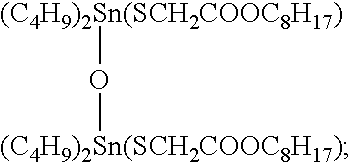Aqueous dispersion and coated product
a technology of aqueous dispersion and coated products, applied in the direction of water-setting substance layered product, transportation and packaging, organic chemistry, etc., can solve the problems of poor storage stability of emulsions, failure to ensure stable quality, and inability to meet the balance of performance including adhesion, weather resistance and stain resistance, and achieve excellent leveling properties and anti-checking properties, excellent adhesion, and water resistance. excellent
- Summary
- Abstract
- Description
- Claims
- Application Information
AI Technical Summary
Benefits of technology
Problems solved by technology
Method used
Image
Examples
example 22
(Example of Showing Alcohol Concentration within the Range Specified in the Invention Just after Polymerization without Any Adjustment)
Components (A) and (B) shown in Table 4, 0.6 part of sodium dodecylbenzenesulfonate and 100 parts of water were stirred at room temperature for 10 minutes to obtain an emulsion, and an 80% aqueous solution of acrylic acid was added thereto. Hydrolysis / condensation reaction was conducted at 40.degree. C. for 2 hours with stirring, and then, emulsification was carried out with a high pressure homogenizer (Microfluidizer M-110Y, manufactured by Mizuho Industrial Co., Ltd.) at a pressure of 70 MPa.
Aside from the above-mentioned emulsion, 40 parts of water and 3 parts of a 25% aqueous solution of Aqualon KH-10 were poured into a four neck separable flask, and nitrogen replacement and heating were carried out with stirring. When a temperature of 75.degree. C. was reached, a radical initiator (an aqueous solution of potassium persulfate) was added, and subs...
examples 23 and 24
Examples of Adjusting Alcohol Concentration within the Range Specified in the Invention by Concentration after Polymerization
Respective components shown in Table 4 were stirred at room temperature for 10 minutes to obtain an emulsion, and an 80% aqueous solution of acrylic acid was added thereto. Hydrolysis / condensation reaction was conducted at 40.degree. C. for 2 hours with stirring, and then, emulsification was carried out with a high pressure homogenizer (Microfluidizer M-110Y, manufactured by Mizuho Industrial Co., Ltd.) at a pressure of 70 MPa. This emulsion was poured into a four neck separable flask, and after nitrogen replacement, a radical initiator (an aqueous solution of potassium persulfate) was added with stirring, followed by polymerization at 75.degree. C. for 4 hours. After the polymerization, the pH of the system was adjusted to 6.5 with a 10% aqueous solution of ammonia. One opening of the four neck separable flask was released, and nitrogen gas was blown therein ...
example 25
Example of Adjusting Alcohol Concentration within the Range Specified in the Invention by Addition of Alcohol
Polymerization was conducted to prepare an aqueous polymer dispersion in the same manner as with Example 1 as shown in Table 1 with the exception that a completely hydrolyzed partial condensation product of alkoxysilanes, that is to say, SH6018 having no hydrolytic alkoxyl group, was used as component (A), and 1 part of methanol was added to obtain aqueous polymer dispersion (25).
Adipic acid dihydrazide (solid) was added to each of the aqueous polymer dispersions (22) to (25) obtained in Examples 22 to 25 in an amount as shown in Table 4, based on 100 parts of the aqueous polymer dispersion, and a 10% aqueous dispersion of dibutyltin dilaurate was added as shown in Table 4 as needed, followed by mixing to prepare each coating agent (clear).
Results of the evaluations for each test piece are shown in Table 4.
Details of various additives shown in Tables 4 and 5 are as follows:
X4...
PUM
| Property | Measurement | Unit |
|---|---|---|
| melting point | aaaaa | aaaaa |
| boiling point | aaaaa | aaaaa |
| particle size | aaaaa | aaaaa |
Abstract
Description
Claims
Application Information
 Login to View More
Login to View More - R&D
- Intellectual Property
- Life Sciences
- Materials
- Tech Scout
- Unparalleled Data Quality
- Higher Quality Content
- 60% Fewer Hallucinations
Browse by: Latest US Patents, China's latest patents, Technical Efficacy Thesaurus, Application Domain, Technology Topic, Popular Technical Reports.
© 2025 PatSnap. All rights reserved.Legal|Privacy policy|Modern Slavery Act Transparency Statement|Sitemap|About US| Contact US: help@patsnap.com



